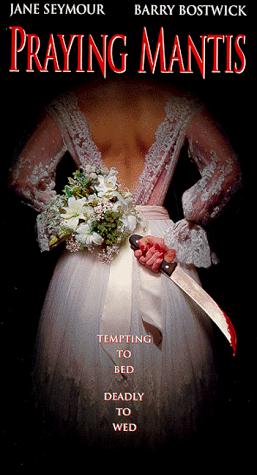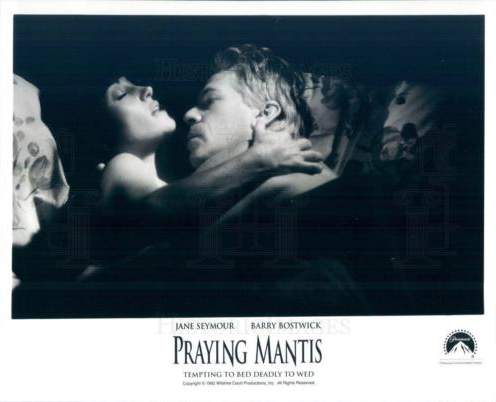Be excited avid RotLA readers as we are finally finding our way to that most prolific and talented of TV actresses Jane Seymour, and, yes, her time spent here in Oregon. We’re sure there have been many of you waiting but there’s a bonus for your patience – “Rocky Horror” and “Spin City” star Barry Bostwick. It really does not get any better than that intrepid readers, and, so without further delay, Raider/Contributor Phil Oppenheim takes you into 1993’s thriller…

It’s time to celebrate the 25th anniversary of a neglected Portland-set, #OregonMade movie that’s all about an insane woman who kills her lovers as they’re just about to make love. Wait, didn’t we just honor Body of Evidence in our most recent Raider installment?
Yep, sharp-eyed reader, that’s true—but this week we’re noting the silver anniversary of the other black widow murder mystery from 1993, the USA network TV movie Praying Mantis. Word to the wise, though: if someone offers you a glass of champagne to toast the flick, pass and grab a can of seltzer or something. You’ll be much less likely to swig some cyanide that way.
Praying Mantis tells the story of a broken woman who plays out a repressed childhood trauma by seducing men, luring them into marriage, and bumping them off on their wedding nights (I’ve spoiled very little; one unlucky hubby drinks poisoned wine and drops dead in the first five minutes). Typical TV movies more often concentrated on Women in Peril; here, the Stalker of the Week variation casts the woman as the villain and turns out to be a lot more fun, thanks mostly to a hilariously nutzoid star turn by Jane Seymour.


Before she was famous for being the most, uh, mature woman to be photographed by Playboy, earlier this year (she’s 67), Seymour was known as the Queen of TV Movies, having made more than three dozen (!) of them; she clearly relishes her cast-against-type role here as a homicidal serial killer, chomping on the scenery with glee. By the end of the movie, she’s worn a variety of funny wigs and wardrobes to create her new personalities; poisoned, stabbed, and bashed with a hammer several innocent victims; excoriates herself in a mirror for being weak and ugly; cuts her arms with a razor blade; cries to her (deceased) mother about how men always leave her; and remorselessly knocks off a few bystanders who get between her and her men. Why does she marry and murder all of these guys? There are hints of some psychobabble explanation, but ultimately, who cares: mostly, the movie has her killing all of those folks because Seymour is so much fun to watch doing it. If you ever decide to give this flick a chance, do not be tempted to pop it out of the VCR before the ending—you’ll miss Jane stuffing wedding cake into her own face, waving around a bloody knife, and screaming at victims and herself, and that’d be as tragic a loss as anything that happens in the film.


TV movies of the 1990s are great for spotting recognizable talent on their way up and down the escalator of fame, and Praying Mantis offers plenty for fans of that game. After Seymour dispatches a husband at the film’s beginning, she starts a hunt for a new victim, setting her sights on indie bookstore owner Barry Bostwick—himself the star of dozens of TV movies and miniseries, the mayor in the series Spin City, and lead Brad Majors of the perennial midnight movie staple The Rocky Horror Picture Show (everybody sing along: “Dammit, Janet!”). Barry’s sister-in-law, who tries to warn him that there’s something fishy about his new fiancee, is played by Frances Fisher, one-time wife of Clint Eastwood and star of his movies Unforgiven and True Crime, among many other movies and TV projects. Bostwick’s son, who unwittingly gets in the way of his would-be stepmother’s evil designs and pays a violent price of his own, is played by the ‘80s pre-teen heartthrob Chad Allen, who went on to play Matthew Cooper in Seymour’s most famous TV assignment, the long-running heartwarmer Dr. Quinn: Medicine Woman.


With all of the TV talent in front of and behind the camera (writers Duane Poole and William Dellingan are TV guys too, for instance), one might expect some TV movie-style aesthetics and sensibilities—and you’d be right. Praying Mantis is by turns outrageously histrionic and thuddingly obvious, fun and breezy one minute and boring and obvious the next. Like many of its ilk, it’s designed as an efficient vessel for at least 16 minutes of commercials during its running time, and once you get into the rhythm and pacing of it you’ll be reminded of how easy a well-tuned TV movie can be to watch (and why they were so popular for decades, too). As a bonus, the unchallenging flow of its plot allows one’s mind to wander while not missing much of the storyline.
Like …
I usually think of female marital murders metaphorically as “black widows” more than mantises; I wonder if black widow spiders’ “copulatory suicide” is anything like that of praying mantises? As you’d expect, there’s plenty to read online about that grisly subject. As a kid, I remember reading that female mantises ate their mates in flagrante delicto heads first; surely there’s some on-demand video available that documents this cannibalistic hanky-panky. Yep, sure is (thanks, National Geographic, for my future nightmares). Given the oral fixation of Seymour’s character (wedding cakes, spiked drinks, fancy dinners), wouldn’t Praying Mantis have been a hundred times more awesome if she had eaten her husbands head first too? Now that’s a movie I’d pay to see! Maybe Jane’s ready to star in Praying Mantis II?


Praying Mantis director James Keach married Jane Seymour (for real) on May 15, 1993; USA ran the movie on August 11, 1993. Isn’t this movie a weird choice for newlyweds to have made? I wonder if Keach slept with one eye open on his wedding night? (The two were divorced in 2013).
Henry VIII’s third wife was Jane Seymour; unlike Anne Boleyn and Catherine Howard—both beheaded, although I don’t think Henry ate them head first—she after giving birth to Prince Edward (later Edward VI). And now that I think of it, in the Herman’s Hermits song “I’m Henry VIII, I Am,” the singer who marries the widow next door is the 8th in a line of husbands who have all been named Henry—do you think it’s possible that his bride is about to eat him head first too?


But perhaps I digress.
Spotters of vintage Portland have plenty to enjoy in Praying Mantis (including a glimpse of the Hotel Vintage, site of the film’s first murder). Jane and Barry dine at the Couch Street Fish House, for instance; the meal ends poorly for the maitre d’ who makes the mistake of flirting with Jane’s prey, and the restaurant itself closed in 2000. Later, the couple plans to move into his grand home in the West Hills (which he claims to have designed himself)—or at least that’s what he thinks his future holds, rather than an early grave.
But the most effective and resonant location is his place of business, and the original site of the couple’s meeting, downtown Portland’s Looking Glass Books. Bostwick brags upon meeting the bookishly shy beauty (who, as the tv trope would have it, is unaware of her own attractiveness, of course) that if his bookstore doesn’t have the book she’s looking for “it hasn’t been written.” That’s a mighty big boast for a book city like Portland, and Portlanders will smirk at his hubris. He continues to brag that he’s got “five stories and growing,” and his eagerness to spread his brand throughout the city reminds us of many other local entrepreneurs who have similarly grand ambitions.
But for cynics and skeptics, these glimmers of arrogance are indicators that the dude is cruising for a fall. And he doesn’t know it, but he’s just met the woman who can hand it to him.


Buy: There’s an amazing PR photo of Jane Seymour on set in Portland and holding the script for Praying Mantis available on Amazon too. Good luck, bidders!
Visit: Sadly, The Looking Glass Bookstore closed for good in March 2011. Take this as a warning: Support Your Local Independent Bookstore! Oregon has a rich bounty of indie shops, and The Oregonian has provided a handy guide to help you plan a few different bibliophilic road trips throughout the state. The Looking Glass is missed, but Portland has an embarrassment of riches, even besides the mammoth and famous Powell’s; make sure to stop by Cameron’s (Portland’s oldest bookstore), Mother Foucault’s, Black Hat, Monograph Bookwerks, Ampersand, Crooked House, and many, many others. Don’t be a shnook, read a book!

